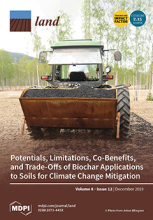Land Library Search
Through our robust search engine, you can search for any item of the over 73,000 highly curated resources in the Land Library.
If you would like to find an overview of what is possible, feel free to peruse the Search Guide.
/ library resources
Showing items 1 through 9 of 18.This study investigates different provisioning services in the peri-urban landscapes of Manila conurbation through a case study of two villages in the Jala-Jala municipality of the Laguna de Bay area in the Philippines.
In a wave of global conservationism, Ecuador established two large protected areas in its Amazon region in 1979. One of these is the Reserva de Producción Faunística Cuyabeno (RPFC), located in the northeastern corner of the country.
Climate change may increase the importance of agriculture in the global Circumpolar North with potentially critical implications for pristine northern ecosystems and global biogeochemical cycles.
Due to their long-term dual structures and rapid urbanization, cities and villages in developing countries are undergoing the challenges of urban-rural integration and ecological security.
As global consumption and development rates continue to grow, there will be persistent stress placed on public goods, namely environmental amenities. Urban sprawl and development places pressure on forested areas, as they are often displaced or degraded in the name of economic development.
Increasing population and rural to urban migration are accelerating urbanization globally, permanently transforming natural systems over large extents.
Social media data provide an unprecedented wealth of information on people’s perceptions, attitudes, and behaviors at fine spatial and temporal scales and over broad extents.
Viewpoint geological and geomorphological heritage sites (geosites and geomorphosites) offer panoramic views over unique geological features and landscapes dominated by significant features. The environmental context is of crucial importance for these sites.
Norway has a political goal to minimize the loss of cultural heritage due to removal, destruction or decay. On behalf of the national Directorate for Cultural Heritage, we have developed methods to monitor Cultural Heritage Environments.





